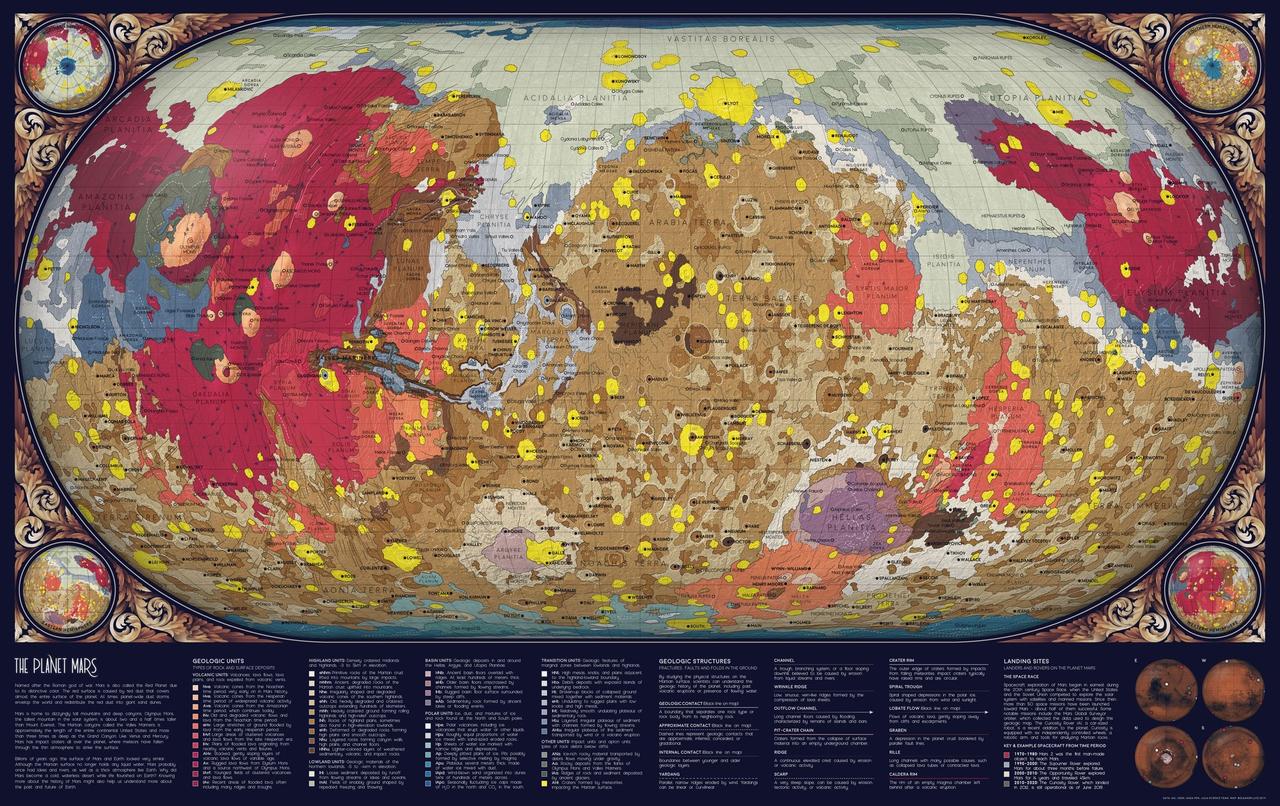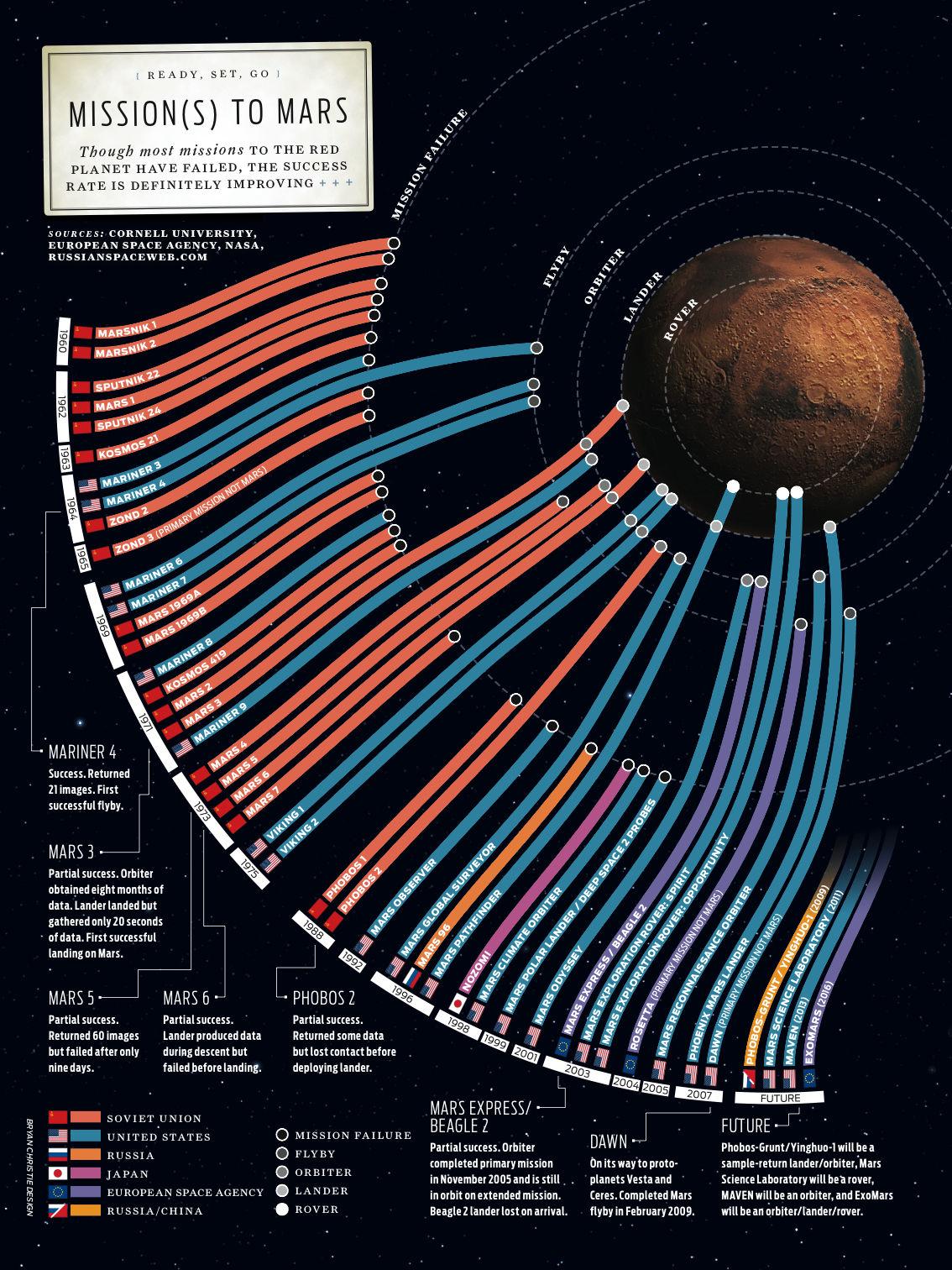For centuries, Mars has been mythically defined by its characteristic red appearance.
In Babylonian astronomy, Mars was named after Nergal, the deity of fire, war, and destruction. In Chinese and Japanese texts, the planet was known as 火星, the fire star.
Although this unique reddish hue has been a key defining characteristic of Mars in culture for centuries, Visual Capitalist’s Nicholas LePan notes that today we now know that it’s the iron oxide soil of the Martian landscape that makes it the “Red Planet” – and that there is much more to Mars than its color upon closer observation.
Above, today’s map, posted and created by Reddit user /hellofromthemoon, brings together the data from centuries of observation and the numerous missions to the Red Planet to map out its geology on a grand scale.
A Red Dot in the Sky
Egyptian astronomers first observed the planet Mars four thousand years ago and named it “Horus-the-red.” Babylonian astronomers marked its course through the night sky to track the passage of time. But it was not until 1610, when Galileo Galilei witnessed Mars with his own eyes through a telescope, that Mars was revealed as a whole other world.
Over the centuries with improving technology, a succession of astronomers observed and crudely mapped out everything from polar ice caps to yellow clouds, and white and dark spots denoting varying elevations across the Martian surface. Some of the earliest maps of Mars date to 1831. But there is only so much you can accurately observe from the surface of the Earth.
On July 14, 1965, NASA successfully received the first up-close images of Mars from the Mariner 4 spacecraft, passing within 9,844 kilometers (6,117 miles) of Mars’ surface. Mariner 4 captured the image of a large ancient crater and confirmed the existence of a thin atmosphere composed largely of carbon dioxide.
Since then, four space agencies have successfully made it to Mars: NASA, the former Soviet Union space program, the European Space Agency and the Indian Space Research Organization. From orbital satellites to surface exploration with robots, each successful mission has brought back important data to develop an evolving picture of the planet.
Here is a complete list of both the successful and failed missions to Mars.
Martian Geology
On Mars, we see volcanoes, canyons, and impact basins much like the ones on Earth. The yellows scattered across the map indicate meteor impacts of varying size while the swaths of red indicate volcanoes and their associated lava flows. The varying colors of brown indicate the cratered highlands and midlands that make up most of the southern hemisphere.
The planet appears asymmetric. Most of the southern hemisphere is heavily cratered and resembles the moon’s highlands. In contrast, the northern hemisphere is sparsely cratered and has many large volcanoes.
Mars is approximately one-half the diameter of the Earth, but both planets have the same amount of dry land. This is because the current surface of Mars has no liquid water.
Mars and Earth are very different planets when it comes to temperature, size, and atmosphere, but geologic processes on the two planets are eerily similar. The sheer size of some landforms on Mars would shadow over similar features on Earth because of the lack of water erosion. This lack of erosion has preserved billion year-old geologic features.
The tallest mountain on Mars and in the solar system is Olympus Mons, and it is two and a half times taller than Mt. Everest. A Martian canyon system, called Valles Marineris, is the length of the entire continental United States and three times deeper than the Grand Canyon.
Mars Colony: Location, Location, Location
The first step to building a colony is to figure out where the best chance of survival is. For Mars, some researchers have identified the planet’s poles, which contain millennia-old ice deposits. These are thought to contain large amounts of ice, which mars settlers could extract and turn into liquid water.
The poles also host other natural resources, such as carbon dioxide, iron, aluminum, silicon and sulfur, which could be used to make glass, brick and plastic. Furthermore, the planet’s atmosphere contains enough hydrogen and methanol for fuel.
Closing the Distance
The map above represents the culmination of centuries of work which we are lucky enough to view here on a computer, conveniently online for us to appreciate and wonder what life’s like on the surface of Mars.
Who knows what more exploration will reveal.
via ZeroHedge News https://ift.tt/2Yyq0FU Tyler Durden

